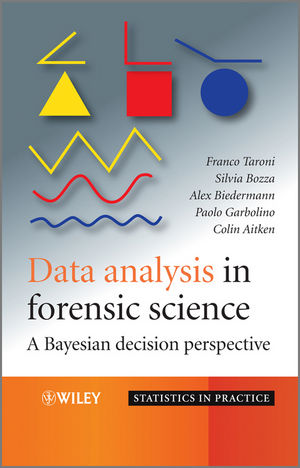Data Analysis in Forensic Science: A Bayesian Decision PerspectiveISBN: 978-0-470-99835-9
Hardcover
388 pages
May 2010
 |
||||||
Preface.
I The Foundations of Inference and Decision in Forensic Science.
1 Introduction.
1.1 The Inevitability of Uncertainty.
1.2 Desiderata in Evidential Assessment.
1.3 The Importance of the Propositional Framework and the Nature of Evidential Assessment.
1.4 From Desiderata to Applications.
1.5 The Bayesian Core of Forensic Science.
1.6 Structure of the Book.
2 Scientific Reasoning and Decision Making.
2.1 Coherent Reasoning Under Uncertainty.
2.2 Coherent Decision Making Under Uncertainty of Reasoning.
2.3 Scientific Reasoning as Coherent Decision Making.
2.4 Forensic Reasoning as Coherent Decision Making.
3 Concepts of Statistical Science and Decision Theory.
3.1 Random Variables and Distribution Functions.
3.2 Statistical Inference and Decision Theory.
3.3 The Bayesian Paradigm.
3.4 Bayesian Decision Theory.
3.5 R Code.
II Forensic Data Analysis.
4 Point Estimation.
4.1 Introduction.
4.2 Bayesian Decision for a Proportion.
4.3 Bayesian Decision for a Poisson Mean.
4.4 Bayesian Decision for Normal Mean.
4.5 R Code.
5 Credible Intervals.
5.1 Introduction.
5.2 Credible Intervals.
5.3 Decision-Theoretic Evaluation of Credible Intervals.
5.4 R Code.
6 Hypothesis Testing.
6.1 Introduction.
6.2 Bayesian Hypothesis Testing.
6.3 One-sided testing.
6.4 Two-Sided Testing.
6.5 R Code.
7 Sampling.
7.1 Introduction.
7.2 Sampling Inspection.
7.3 Graphical Models for Sampling Inspection.
7.4 Sampling Inspection under a Decision-Theoretic Approach.
7.5 R Code.
8 Classification of Observations.
8.1 Introduction.
8.2 Standards of Coherent Classification.
8.3 Comparing Models using Discrete Data.
8.4 Comparison of Models using Continuous Data.
8.5 Non-Normal Distributions and Cocaine on Bank Notes.
8.6 A note on Multivariate Continuous Data.
8.7 R Code.
9 Bayesian Forensic Data Analysis: Conclusions and Implications.
9.1 Introduction.
9.2 What is the Past and Current Position of Statistics in Forensic Science?
9.3 Why Should Forensic Scientists Conform to a Bayesian Framework for Inference and Decision Making?
9.4 Why Regard Probability as a Personal Degree of Belief?
9.5 Why Should Scientists be Aware of Decision Analysis?
9.6 How to Implement Bayesian Inference and Decision Analysis?
A Discrete Distributions.
B Continuous Distributions.
Bibliography.
Author Index.
Subject Index.



